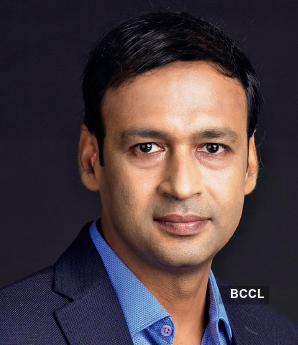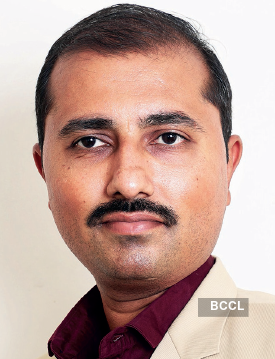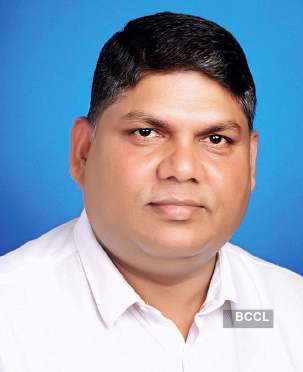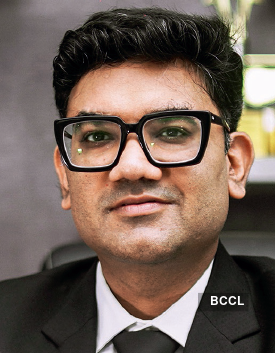He engaged with hoarding agencies (billboard owners) for multi-layer flex printing technology. This is a clever advertising strategy where Agarwal sought to have his campaigns printed on a base layer and installed them as the permanent base layer directly on the billboard’s mounting surface.
Larger advertisers would mount their campaigns as temporary overlays, on top of his base advertisements, so that they could be removed after their contracts were over. When the premium advertisers’ campaigns ended and were removed, Agarwal’s base layer advertisement became visible again, gaining ‘free’ exposure during the transition periods. It cost him less than the premium rates for front-layer visibility. Persistence paid off, as his advertisement though often hidden, reappeared during campaign changeovers — all at a fraction of the cost.
It’s a form of guerrilla advertising that maximises reach while minimising costs, perfect for MFDs trying to build brand recognition in smaller markets. This low-cost strategy reflects the resourcefulness of MFDs in driving financial inclusion in India’s smaller towns and cities.
It’s a perfect example of how they’ve had to think creatively to compete with larger players while serving markets often overlooked by bigger players.
Small change, big exchange
It’s not just the larger cities of India that bring in mutual fund distributors. Small towns — beyond the top 30 cities (B30) in MF industry parlance —also bring in significant inflows. Nearly 19%of the overall Assets Under Management (AUM) of MFs came from B30 towns as of March 2024, up from 15.3% in March 2019, as per AMFI-Crisil Factbook 2024. Assets from B30 locations increased from Rs.13.28 trillion in May 2025 to Rs.13.80 trillion in June 2025, representing a 4% rise. “We have seen a lot of hunger in these guys,” says Kalpen Parekh, Managing Director and CEO, DSP Mutual Fund.
Meet Dev Patel, an MFD from Korba, a small town with a population of 3.63 lakh, in Chhattisgarh. Patel had a hard upbringing. His mother passed away when he was small, and he moved in with his uncle and aunt, who raised him. Due to financial constraints, when he was in Class 6, he started distributing newspapers at 5 am to 75 houses, which earned him Rs.300 a month. When he entered class 8 at school, he took on another part-time job at a garment shop, working from 5 to 10 pm, making an additional Rs.700 per month. The family didn’t have the money to pay for his education after he passed his 12th exams, so he dropped out and took up a full-time job at Hindustan Unilever, selling soaps and other products to kirana stores. Patel was mindful of the many dacoities that had plagued Korba at the time; it put him at risk as well, as he had to transport cash from the kirana stores to his company. In 2002, he entered financial product sales, working with Sahara Corporation and Life Insurance Corporation (LIC) until 2013, before switching to mutual funds.

Prabin Agarwal, 47,
Siliguri
1994-95
First investments (two mutual funds + two stocks) at around age 16
2005
Became a sub-broker with Anand Rathi
2008
Attended a seminar, got convinced that SIP is the way forward; organised an investment awareness camp at a hotel where 65 turned up, some of whom became clients; started mutual fund distribution (with 3 office staffers)
2015-16
Started billboard advertisements
Now 2025
Staff of 25 people
AUM: Rs.700 crore
Korba is a mid-sized town renowned for its coal mines and power plants, including those operated by NTPC (National Thermal Power Corporation) and the Chhattisgarh State Electricity Board. Patel says that nearly 90% of his clients are government sector employees. He says that initially, lump-sum money was scarce, so he encouraged all his clients to start systematic investment plans (SIPs). “I imbibed goal-based investing, not newsbased investing,” says Patel, who says that 95% of his MF inflows come in equity funds.
This, incidentally, is the strategy many small-town MFDs follow. Avnish Bhatnagar, Director & Co-Head of India Retail Sales at Franklin Templeton, says that as we travel deeper within India, MFs are still closely associated with equities. “There is not much understanding of hybrid and fixed income MF schemes,” he says. He explains that most investors in small towns are already well-invested in FDs and small savings. What’s been missing from their portfolios was equities, and that is where equity MFs come in.
Patel, who couldn’t complete his education, today manages Rs 115 crore worth of his clients’ money. Korba manages assets worth Rs.4,022 crore as of June 2025, ranking 136th among Indian towns in mutual fund investments, according to CAMS, one of India’s largest registrar and transfer agents.
Beyond FDs: New frontiers
Manish Kothari, co-founder and CEO, ZFunds, a platform that empanels distributors, says that investors in small towns are getting younger and wealthier. He says that it’s easy for someone in their 20s to open an account on one of the several digital platforms that sell MFs and start a Rs.500-1,000 SIP. But when her portfolios become worth, say Rs.50 lakh, she needs some serious advice. Kothari says that rural India is no longer necessarily poor or conservative.

Anand Zinzuvadia, 40,
Amreli
1988
Father started financial distribution business; (equity IPO, Unit Trust of India, fixed deposits and small-savings)
2001
Father got AMFI licence and started selling mutual funds
2004
Anand and his brother (Gopal Zinzuvadia) joined the business
Anand’s responsibility: Mutual funds
Brother’s responsibility: Equity stock broking
Now 2025
AUM: Over Rs.280 crore
(approximately Rs.140 crore from Amreli and surrounding towns, Rs.140 crore from other cities and states across India)
Siliguri’s Agarwal says SIP sizes in small towns have grown from Rs.5,000-10,000 to much larger amounts, including Rs.2 lakh from a family of four, with some also investing in cryptocurrencies. “The crypto craze peaked 2-3 years ago, with many local chartered accountants calling me to understand its taxation,” he adds. To put it in perspective, with a total AUM of Rs.9,715 crore as per data by CAMS, Siliguri is ranked 65th in terms of AUM in India. In fact, Parekh states that small towns have substantial NRI (non-resident Indian) wealth. This transformation has pushed local MFDs to not just embrace technology for customer service, but also master asset allocation and wealth management. The old stereotype of the briefcase-carrying LIC agent is well and truly buried.
Bhanu Pratap Jain operates from Tinsukia, a remote town in Assam, located near the border with Arunachal Pradesh. Don’t let the geography fool you about local ambitions. This ex-Oracle employee had a job offer in Cyprus but chose to return to his hometown in 2005 instead. He walked into DSP Mutual Fund’s Mumbai office for guidance, and soon launched his own distribution business. Jain adopted technology faster than many others at the time. He once cut CDs with India growth story presentations to convince people to invest in MFs. Now fully digitised, Jain says most of his clients were first-time MF investors who, despite setbacks like the 2008 crisis, have grown into HNIs. Tinsukia’s AUM stands at Rs.3,642 crore, ranking 150th in India.
Converting doubt and delays
Some distributors, like Anand Zinzuvadia, 40, have taken their family business forward. His late father had started his financial distribution business in 1988, selling equity IPOs (initial public offering), Unit Trust of India, fixed deposits and small savings. In 2001, he diversified to selling MFs and insurance policies when private insurance companies started to make inroads. Zinzuvadia joined the family business in 2004 to sell MFs, while his brother Gopal handled equity broking, facing a major hurdle in low financial literacy.

Dev Patel, 45, Korba
1992
Started selling newspapers (early mornings) earned `300 a month; in Class 6 that time
1994
Took up additional part-time job at a garments shop (5-10 pm); Class 8 at school
1998
Passed Class 12 and quit education due to constraints; took up full-time job at Hindustan Unilever, became a Sahara Corporation agent selling FDs
2003-2013
LIC agent
2008
Passed AMFI’s Mutual Fund distribution exam.
2013
Started selling mutual funds
Now 2025
SIP book:Rs.77 lakh per month
AUM:Rs.115 crore
“In those days, people used to earn 10-12% in FDs. Convincing people of volatility and long-term returns was tough,” says Zinzuvadia. He recalls that businessmen and professionals, such as doctors and lawyers, knew better than an absolute lay investor, although they, too, were hesitant back then. He tried a novel approach. He started investing his own money in MFs and then showed his account statements to his potential clients. Over time, compounding showed. Numerous IAPs and visits to homes later, Zinzuvadia managed to convince people to invest 20-30% of their FDs that would have otherwise been redeemed. It all started with lumpsum investments of as little as Rs.1,000 and SIPs of around Rs.500. As markets rewarded long-term investors, trust grew. He tells us the tale of one of his clients who started off with Rs.1,000 SIP in 2008 and who now invests Rs.60,000 a month in SIP. Today, the same investor’s portfolio is valued at Rs.1.5 crore.
Zinzuvadia still conducts IAPs regularly. On 28 June, his IAP drew 1,400 people to his hometown of Amreli, Gujarat, a city with a population of two lakh. From around 18,000 new SIPs registered in Financial Year 2023, Amreli saw little over 47,000 registered in 2024-25, as per CAMS data. In terms of AUM, it ranks 194th in India, with Rs.2,503 crore as of June 2025.
Many small-town distributors had an additional challenge of having set up their businesses at a time when cheques took a longer time for clearances and forms had to be sent to mutual fund offices far away. From the introduction of At-Par cheques in the 1990s-2000s to the Speed Clearing system introduced in the early 2000s, and the modern Cheque Truncation System first introduced in 2008, MFDs in smaller towns had to bridge not just the financial literacy gap but also the technology divide.

Bhanu Pratap Jain,43, Tinsukia
2005
Left job at Oracle and moved to hometown Tinsukia; started mutual fund distribution at age 23; rising equity markets helped garner inflows.
2008
Investors panicked after the global credit crisis and market crash; adopted technology to make selling efficient.
2012-13
Transitioned to goal-based financial planning and started recommending SIPs
2016-17
Demonetisation breakthrough: Doubled AUM from Rs.10 crore to Rs.20 crore in 9 months as clients shifted from real estate/FDs to MFs
2020-21
Leveraged tech during Covid for new clients undefined Rs.80 crore AUM by March 2022
Now 2025
AUM: Over Rs.200 crore (up from Rs.100 crore as on June 2023)
“India’s entrepreneurs, from small towns to big cities, have been creating and monetising businesses, especially in recent years. As the older generation passes the baton and capital flows surge into diverse sectors, many families are witnessing significant wealth creation. At the same time, robust market returns are pulling NRIs back to invest in Indian equities. This twin trend has created a massive demand-supply gap for professional wealth management. In smaller cities, sincere and passionate MFDs are stepping up to help these families build disciplined, long-term portfolios. It’s a golden opportunity for trusted advisors to make a real difference,” says Parekh.





